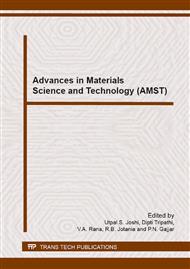p.121
p.125
p.129
p.133
p.137
p.143
p.147
p.151
p.156
Design and Construction of Low Temperature Attachment for Commercial AFM
Abstract:
With the rapid advancements in the field of nanoscience and nanotechnology, scanning probe microscopy has become an integral part of a typical R&D lab. Atomic force microscope (AFM) has become a familiar name in this category. The AFM measures the forces acting between a fine tip and a sample. The tip is attached to the free end of a cantilever and is brought very close to a surface. Attractive or repulsive forces resulting from interactions between the tip and the surface will cause a positive or negative bending of the cantilever. The bending is detected by means of a laser beam, which is reflected from the backside of the cantilever. Atomic force microscopy is currently applied to various environments (air, liquid, vacuum) and types of materials such as metal semiconductors, soft biological samples, conductive and non-conductive materials. With this technique size measurements or even manipulations of nano-objects may be performed. An experimental setup has been designed and built such that a commercially available Atomic Force Microscope (AFM) (Nanosurf AG, Easyscan 2) can be operated at cryogenic temperature under vacuum and in a vibration-free environment. The design also takes care of portability and flexibility of AFM i.e. it is very small, light weight and AFM can be used in both ambient and cryogenic conditions. The whole set up was assembled in-house at a fairly low cost. It is used to study the surface structure of nanomaterials. Important perovskite manganite Pr0.7Ca0.3MnO3 thin films were studied and results such as morphology, RMS area and line roughness as well as the particle size have been estimated at cryogenic temperature.
Info:
Periodical:
Pages:
137-142
Citation:
Online since:
November 2013
Price:
Сopyright:
© 2014 Trans Tech Publications Ltd. All Rights Reserved
Share:
Citation:


